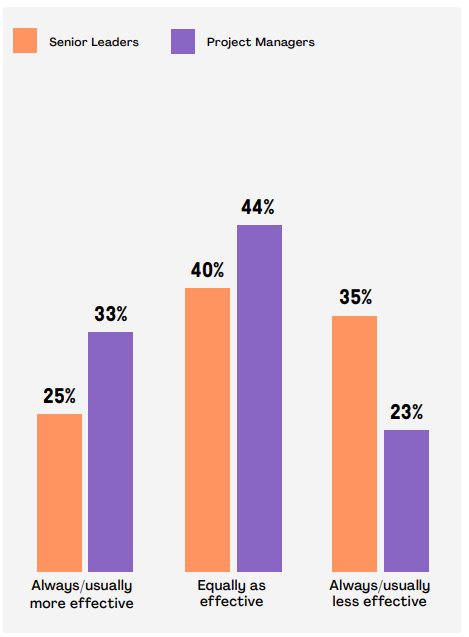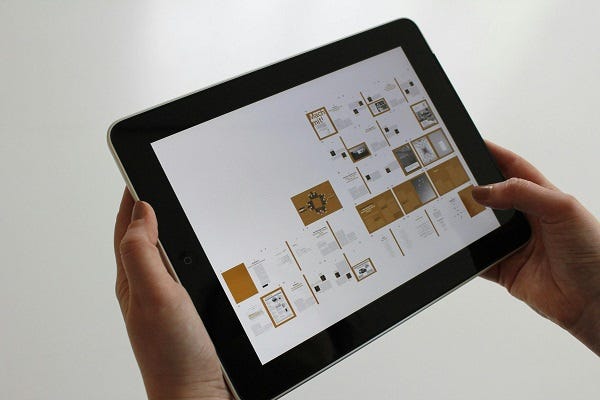The Myth Of Home Working
How To Improve Perception on Productivity
Hey, fellow Leader 🚀,
I am Artur and welcome to my weekly newsletter. I am focusing on topics like Project Management, Innovation, Leadership, and a bit of Entrepreneurship. I am always open to suggestions for new topics. Feel free to reach me on Substack and share my newsletter if it helps you in any way.
The PMI pulse of the profession for 2024 is out and one of the topics covered is whether the productivity is higher working from home or an office. While the data currently shows there is no significant difference from both sides of the spectrum, the reality is some organizations are not 100% bought with the idea of home working, while benefiting themselves greatly by the usage of the practice.
This article will not cover the advantages and disadvantages of either methodology but focus on the data and how to leverage the perception the way of working is hopefully changed forever. Below is another article covering some challenges and solutions for managing a team remotely.
What the Pulse is Saying
I would argue some people consider their days working at home, by purely remote work or hybrid work, to be a guaranteed win, and is difficult to see a reality where people will go back to the office full time like in old times. Unfortunately, I don’t see things this way, and the discussion about whether office work should be back is something I keep reading online and experiencing myself.
For this particular topic, I am biased towards the use of hybrid or remote working. So my articles will be written in the light of empowering these practices instead of resorting to old ways of working.
The graph above shows the perception of organizational leaders about the productivity of remote work. These figures are important since we can see that 35% and 23% of decision-makers consider remote work less effective than office work. The interpret better these figures is important to note PMI covers a lot of industries, not only IT. So these numbers take into consideration project management in construction for example, which has different needs from Software development or management. Nevertheless, creates an awareness of how some decision-making staff can have regarding the use of remote working. The same report shares there is a marginal difference in performance independently if working from home or remote. Which denotes there is significant unfounded concern about working outside an office environment.
An important note is hybrid work setups, have their specificities while wetting the feet on both worlds, therefore some insights will be dedicated to this setup exclusively. In this article, I will provide guidelines and strategies for helping mitigate the concerns regarding outside the office setting:
Mindset shift towards working from home
Metric focused approach
Types of collaboration done better while online
Hybrid: The Office Day is now an event
Hybrid: Respect the rules of the framework
Mindset Shift
This reminds me of a story from my early developer days, where there was one developer who spent his days commenting and uncommenting code (I might be exaggerating a bit here), but when I asked the manager about this colleague, the reply was he was an example for our juniors because he was always fixing problems and producing code. Well, the output of his work was always the same: He wasn’t producing anything meaningful, but yes, he looked busy.
This mindset is what needs to be changed. There is a difference between looking busy and being productive. One of the advantages of working remotely is the output of work speaks louder than a status on Teams or commenting code at the office. Is easier to understand who are the most productive staff, because management doesn’t get distracted with apparatus.
Therefore, it is important to celebrate victories or achievements. If a team or a set of developers finished or fixed a complex task, this needs to be celebrated. Any positive progression to an OKR or KPI should be highlighted. Not only for the morale of the workgroup but also to shift the mindset from valuing what would be unproductive work, to advancements on results.
The old ways of work at the office gave especially temptations for micromanagement practices, which is an alert raised in all quality leadership literature. The remote work setting forces a change to trust and build comprehensive milestones and trackable progress. If you are already doing this, is great!
In a way, a remote work setting, forces bad leaders to become better. By learning and navigating with data, producing better decisions as a by-product.
Metric approach
In the same manner, what cannot be measured cannot be improved, it is highly important to define what makes a quality output for the team’s work For that reason setting up objectives and measuring how close we are to fulfilling those objectives (hint: OKR) can play an important improvement for any team.
A good implementation of remote working requires the implementation of metrics and KPIs to measure the quality output. The easiest metrics are implementing check-up stages while getting closer to a milestone. But the team should have more to assess the work. Code quality and project Actuals can be other forms of assessing the effectiveness of remote working. Agile methodologies might help already with these needs since they inherently produce metrics to assess the team’s productivity and output.
However, the problem with technical metrics is their relation with productivity is not always a direct link. The stakeholders might not understand these metrics and how they reflect on the product. For that reason is important for the project manager to define metrics that are product and sponsor-oriented.
Collaboration done better
Depending on the organization collaboration tactics can be made easier or difficult. Not all companies have a whiteboard and post-its, and if they have them, not all have working pens. This is especially true in bigger organizations where the procedure of refilling some office supplies is hidden in a black hole. This is where online tools can shine and offer more possibilities than offline tools.
One of my favourite tools is Klaxoon which has a free version. The templates this kind of tool offers can be indeed a game changer for collaboration. Nevertheless is another tool that a manager needs to master to get the full potential. This beats offline methods and its spread use is made possible due to home working setups being more common.
The tools are getting better and is only a matter of time before Artificial intelligence is used to interpret the meeting’s audio and produce a minute of the meeting. The technology is already here but requires some technical knowledge. For example, this source from ChatGPT 4 requires knowledge of Python. But in the same way, AI can resume a PDF document, if you have access to this kind of service, you might try to use a meeting’s transcript and ask ChatGPT to produce a meeting’s minutes.
Needless to say, this is a major step up from old-fashioned meetings where people lose time by going to a meeting room, waiting for everybody to be present, connecting a laptop to a screen or other form of digital tool, avoid losing time due to technical problems connecting to WiFi or peripherals, have the meeting, after the meeting produce the minutes.
Hybrid setup: The Office Day
For organizations using a hybrid model the days at the office should be different and avoid the old style of working with headphones all day. For this model, Office Day is an opportunity to connect with the team and other colleagues and strengthen or increase your network inside the organization. Office Day can be used for team-building events or exercises, the exchange of ideas and their practicalities, anything that requires discussion, or other forms of exchange.
For Agile teams the Office Day can be used for the Scrum ceremonies if the Scrum Master sees the added value of doing it in person. But my major suggestion is to make the one-on-one meetings in person, only! It’s one of the few things where online work loses points to office work. Person-to-person contact is made better in real life sharing the same physical space, which is tremendously important in one-on-one meetings. Not only the manager can have a better perception of the team members, but verbal communication goes so far. Any skilled leader or negotiator will argue that non-verbal communication like body expression is highly important. Because only a percentage of communication comes from words, and unless we are using Star Wars technology to create a full-body hologram from a galaxy far away, doing these meetings in person has a lot of value.
Use Office Day to your advantage. As a personal note, since I am working on a hybrid setup, I can access decision-maker staff more easily today than when everybody was working at the office. There is less clutter and obstacles to reach them. There is real added value here. So it’s my invitation to you to use it.
Hybrid setup: Just respect the rules…
The battle of working from home is not won. Far from it. The PMI 2024 pulse shows a great percentage of decision-makers are still not convinced. In the news and can read and watch companies that were working fully remotely, are now calling staff for a hybrid setup. The myth that people are more productive at home than at the office will eventually crumble since data is showing there isn’t much difference. There are advantages to both setups, but what will define the future is the value for the stockholder. If companies see their profits diminish, emergency measures will happen next.
For these reasons, we should respect the rules for hybrid work. Going to the office when scheduled, we should avoid situations where colleagues arrive at 10 am and go out at 4 pm and compensate for the missing hours when working from home. We should be on the lookout for any oddity because these will be the arguments used to denigrate the work-from-home policy.
My recommendation is to consider these behaviors while hiring or firing staff. Is now part of the code of conduct, and the focus should be to highlight the positives of working from home instead of losing time explaining the basics and what should be clear in the first place. Companies benefit from flexibility, value, staff quality, and overall working environment while working from home. Any distractions should be managed by us.
That’s it. If you find this post useful please share it with your friends or colleagues who might be interested in this topic. If you would like to see a different angle, suggest in the comments or send me a message on Substack.
Cheers,
Artur







"These figures are important since we can see that 35% and 23% of decision-makers consider remote work less effective than office work."
But this means that 65% and 77% of them feel that it does NOT make it less effective which is a much better talking point to me.
Also, this: "The myth that people are more productive at home than at the office will eventually crumble since data is showing there isn’t much difference.". But this is not what is argued by the RTO gang. What they always try to convince us is that if you're not in the office you're not AS productive. I didn't realize that now, the standard is that you had to be MORE productive at home than in the office. I thought being equal would be enough but apparently that's not the case anymore. If the productivity is the same, plus all the benefits, then, I still don't see any valid reson for mandatory office days. Make the office available for those who want to use it, and let people work as they wish.